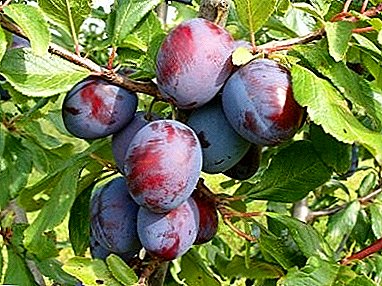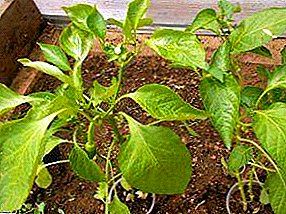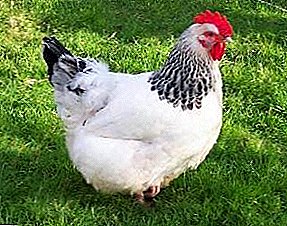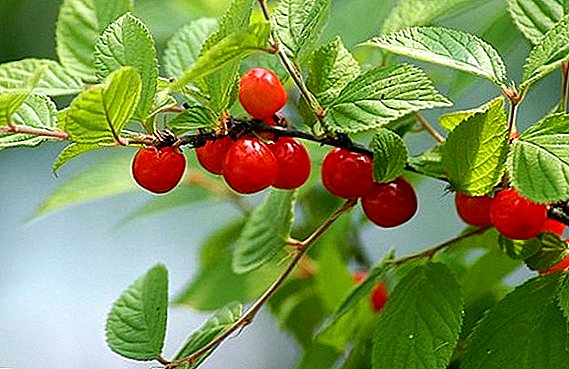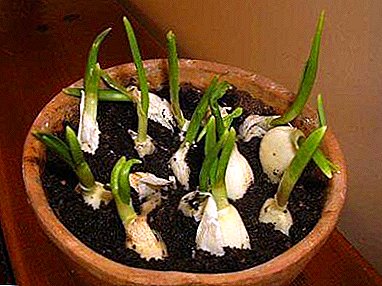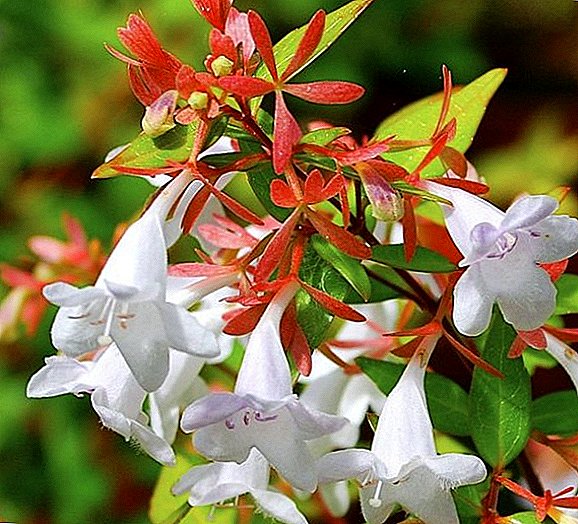 Country owners are ready to compete with their neighbors, whose flowers are more beautiful. Many dream to get a cozy gazebo for relaxing, green and surrounded by fragrant bushes. For these purposes, ideal abelia garden, which will be discussed further.
Country owners are ready to compete with their neighbors, whose flowers are more beautiful. Many dream to get a cozy gazebo for relaxing, green and surrounded by fragrant bushes. For these purposes, ideal abelia garden, which will be discussed further.
Botanical description
Abelia is an evergreen shrub or deciduous shrub (depending on the type of plant), whose height is 1.5-2 meters and the same in diameter. There are wild specimens, whose height can reach 5-6 meters. Shrub belongs to the family Honeysuckle, and, accordingly, its flowers have a very powerful aroma.
The leaves of abelia are saturated green, glossy, almond-shaped, arranged in pairs. Flowers of the plant have the form of a bell and a tubular structure, consist of 5 petals of white or pink shades, possess a bright aroma.
Fans of flowering shrubs should pay attention to the magnolia, forsythia, lilac, Japanese spirea, rhododendron, hibiscus, Japanese quince, heather, weigel.

Did you know? The bush, despite its Eastern origin, got its name in honor of an English explorer, doctor and botanist named Clark Abel, who conducted a study of vegetation in China and India.
Kinds
The genus of Abelia includes at least 15 species of plants and their hybrid descendants, but not all varieties are suitable for garden cultivation, the majority of varieties are intended for greenhouse cultivation. Nevertheless, we consider the most popular types of this shrub with gardeners:
- Abelia grandiflora, it is grandiflora, is one of the largest representatives of this plant. Shrub can reach a height of 6 meters. This species is a hybrid of Chinese and one-flowered Abelia, which determines its impressive dimensions. The flowers of the plant are funnel-shaped, white, pink, lilac in color, are collected in inflorescences and are located along the entire length of the shoots, but most of them are concentrated at the end of the branch, have a strong sweet aroma. Like many hybrid plants, unpretentious in the care and has a long flowering period: from June to the end of September, which makes it the most common in garden plots;

Did you know? According to one version, the name of Abel comes from a similar Hebrew name, which translates as "breath" or "breath." And they associate the emergence of this variant with the fact that the plant has an intense, volatile aroma.
- Chinese Abelia is a medium-sized shrub, not exceeding 2 meters, has dense green oval pointed leaves and white fragrant flowers in red sepals with red grooves. It blooms from May-June to the end of September, it is considered a semi-evergreen shrub, because after the flowers fall, the foliage remains, which changes color from green to bronze;
- Korean abelia - it is the most resistant and hardy type of a bush, is frost-resistant. Flowering continues from spring to late autumn, after its completion there are red-orange leaves. The flowers are usually white or white and pink, have a very bright and strong odor compared with other counterparts;
- abelia variegate is a favorite with flower growers, because it grows well in both home and garden conditions. It blooms with white bells with a honey aroma. The most common variety of variegated Abelia with the romantic name "Kaleidoscope", its distinctive feature is the foliage: in spring and summer it retains the usual green color, and in the fall becomes a motley, yellow-red shade.



Check out the list of the most popular shrubs with white flowers.
Growing up
To grow shrubs in the garden, you must carefully select the appropriate conditions for its existence. Bushes are planted either in autumn or in early spring, when night frosts have already stopped:
Important! Abelia due to the large volume of the bush in combination with the fragility of the branches absolutely does not tolerate drafts, so the area should be ventilated, but protected from intense air currents that can damage the delicate plant.
- First of all, you need to choose the right place, because Abelia loves light very much, but does not tolerate direct sunlight very well.
- The plant belongs to the heat-loving crops, so it tolerates hot weather calmly, provided that the irrigation regime is not disturbed. Winter cold for him is not the most comfortable time. Up to 10 degrees of heat abelia retains foliage, if a sharp drop in temperature occurs, it drops foliage.
- The plant is moisture-loving, but it is not necessary to overfill it to avoid root decay.
- The soil for the plant should be on the basis of sod, peat and sand, very nourishing and breathing, with good draining properties. The hole for planting a bush should be slightly larger than the earthen room in which the plant is to be transplanted, drainage stones are poured at the bottom of the hole;
Care
The plant does not require any specific care, it is enough to follow simple rules that are standard for most garden shrubs.  To maintain the beautiful shape of the bushes, they should be regularly cut and pinned. Pruning is done during the rest period, in the spring after the end of frosts.
To maintain the beautiful shape of the bushes, they should be regularly cut and pinned. Pruning is done during the rest period, in the spring after the end of frosts.
Watering
Abelia likes moderate watering and does not tolerate stagnant water in the soil, so you need to water it after the topsoil dries completely. In addition, it is imperative to organize good drainage and regularly loosen the ground around the bush to evaporate excess moisture.
Important! At the same time, abelia feels comfortable when the air humidity is quite high, so you need to periodically spray the plant with cool water from spring to autumn.
Temperature conditions
Given the regions of origin of the plant, it can surely be called thermophilic. Abelia does not tolerate drafts and feels perfect at a temperature of 20-25 degrees Celsius. In winter, the comfortable temperature for a bush is not lower than 10 degrees Celsius. For most varieties of additional shelter in the winter is not required, it is enough to protect the bush from the draft. However, Schumann's abel is not as stable as other varieties, it is recommended to cover it with sacking or other types of insulation for plants during the winter. 
Top dressing
To speed up growth and stimulate flowering, Abelia is recommended to feed twice a month in the spring and summer period. For these purposes, suitable ready-made mineral fertilizers suitable for shrubs. In winter, there is no need to feed.
Check out the best ornamental shrubs to give.
Breeding
The reproduction of the bush is possible in several ways: cuttings, seeds or root processes:
- Cutting involves the use of cuttings or shoots that remain after pruning the plant, better tolerate apical cuttings. To obtain the best result, cuttings cut in early spring are rooted in a special sandy-peat substrate and kept at a temperature of 18-20 degrees, then they are transferred to large pots. It is better to plant a young shrub in spring. Cuttings grow fairly quickly, but this method of reproduction is rarely used due to poor rooting of shoots.
- Seed abelia propagated by sowing them in January. If the seedlings sprout, then the growth is very intense, and flowering bush can begin in the same year. Seed propagation is complicated by the fact that germination of seeds is very low.
- The best result can be achieved by reproducing abelia with the root shoots. In this case, a shoot is taken from the mother bush with a part of the root and transplanted immediately to a permanent place.

Transfer
The plant grows very intensively, so it is better to replant young bushes 2-3 times over the summer. Older shrubs can be transplanted less frequently, usually once every 2-3 years.
In order for the site to be beautiful all year round, pick up ornamental, flowering, cold-resistant shrubs to give.
Diseases and pests
Abelia is quite resistant to various diseases, however, it is rarely avoided by the standard for shrubs diseases and pests.
- Most often the bushes attempt to aphid, especially young plants suffer. To combat the pest can be used as a rinse with a solution of soap (it is important to cover the root zone so that the solution does not get under the root) and ready-made industrial pyrethroids.
- On bushes often appear black, small insects almost stick around the plant. Usually they are removed mechanically, trying not to damage the bark, and then for 3 weeks the shrub from parasites is treated with a special insecticide, and then with a fungicide to destroy the spores of the fungus.
- Spider mite also affects abelia. Many gardeners make the mistake of using standard insecticides to kill this pest. Spider mite belongs to arachnids, so only special insectoacaricides can effectively fight it.


Cultivation Reviews
All abelias smell, but the smell differs from the variety, although it is very subtle and pleasant in all. In the pots I already have large bushes in bloom, a meter in diameter, no less. In the ground, Abelia (only in the south) must be planted only from May to early August and deeply buried. It is the buried planting that gives further wintering. On all the buried parts of the svols, additional roots are formed, in winter the plant measures less, in the summer the root one becomes less heated. I do not water often, but she doesn’t mind either, even in strong heat, a deep landing helps out again, she gets enough food for herself.
Who tried to propagate abelia, knows that it is not so easy. Rooted for quite some time. Of the 10 cuttings can be taken 2-3. It gives initially thin lifeless roots and here is the most important thing, to plant and preserve the plant on such roots and even translate into adulthood.




